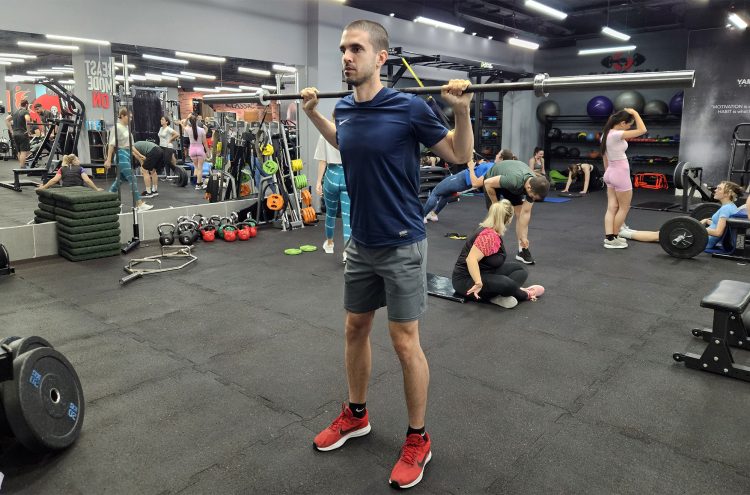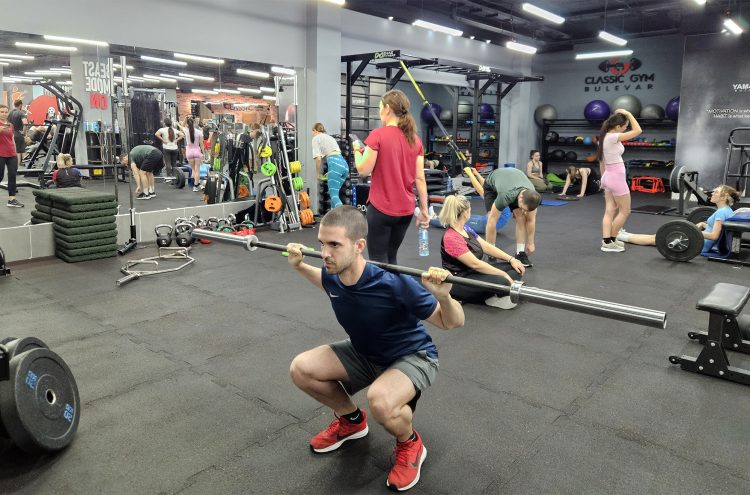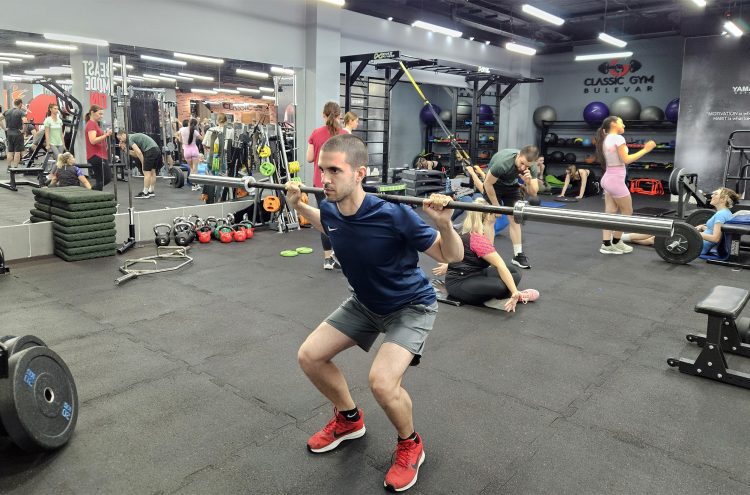Growing quads isn’t easy, especially if you only train legs once weekly. This is where one-and-one-half squats shine. Squeezing in a few extra reps in each set can increase the time under tension (TUT) and total weekly volume, leading to significantly greater stimulation.
A randomized controlled trial investigated the impact of range of motion on hypertrophy. The results showed that the lengthened range of motion (bottom half in this case) was more effective for promoting hypertrophy than the full range of motion. This suggests that one-and-one-half squats are among the best exercises to ignite lower body growth. (1)
So, let’s learn more about it.
How To Perform One-and-One-Half Squat
Here’s how to perform one-and-one-half squats the right way:
Step One — Assume the Starting Position
Stand with your feet shoulder-width apart and toes pointing outward slightly. Keep your chest up, spine neutral, and core braced.
Level Up Your Fitness: Join our 💪 strong community in Fitness Volt Newsletter. Get daily inspiration, expert-backed workouts, nutrition tips, the latest in strength sports, and the support you need to reach your goals. Subscribe for free!
For the weighted one-and-one-half squat, position the barbell high on your back. Grab the bar with your hands slightly wider than shoulder-width apart.
Pro Tip: Take a deep breath and hold it during the descent. It will also help keep your spine stable.
Step Two — First Descent
Lower into a squat by flexing your knees and pushing your hips back as if sitting down on a chair. Go as low as your mobility allows.
Pro Tip: Ensure that your knees don’t flare on the eccentric phase. This will prevent additional stress on your knees.
Step Three — Rise Half-Way Up & Lower Back Into the Hole
After a brief pause in the bottom position, rise up halfway according to your range of motion (ROM) while pushing through your heels. Slowly descend back into a deep squat.
Pro Tip: The fully stretched position is considered the most hypertrophic, so stay in control during the descent.
Step Four — Return to the Standing Position
After returning to the bottom position, drive through your heels to return to the starting position. Repeat for reps.
Pro Tip: Contract the glutes in the fully shortened position to maximize target muscle stimulation.
Watch Filip Maric perform the 1.5 Method for Squat:
What Do Sport Scientists and Professional Bodybuilders Think About Half-Reps?
In his conversation with fitness content creator and natural bodybuilder Jeff Nippard, a sports scientist, Dr. Milo Wolf (Ph.D. Sports Science) stated:
“We’re expecting an improvement in your growth of maybe 5 or 10% using lengthened partials versus full range motion, so if you’re all about maximizing your hypertrophy, that’s meaningful.”
When asked about how much of a range should a partial rep cover, Dr. Milo said:
“To get the full benefit of lengthened partials, you probably do want to cut the range of motion down by a pretty substantial amount. Otherwise, you wouldn’t get the benefit. So, I think about half reps is a really good starting point.”
Muscles Worked
Here are the muscles worked during the one-and-one-half squat:
Quads
The quadriceps are the primary muscles worked during the one-and-a-half squat. They are extremely active during the eccentric and concentric phases. The quad engagement during one-and-a-half squats is second to none, thanks to the extra half-squat and prolonged time under tension.
Level Up Your Fitness: Join our 💪 strong community in Fitness Volt Newsletter. Get daily inspiration, expert-backed workouts, nutrition tips, the latest in strength sports, and the support you need to reach your goals. Subscribe for free!
Hamstrings
The hamstrings work in synergy with the quads by assisting knee flexion. They’re the most active during the eccentric portion (lowering into a squat). Hamstrings help control the weight and prevent you from falling forward. They also assist with hip extension.
Glutes
The glutes are heavily involved in extending the hip joint, particularly during the ascent. The glutes stay active throughout the entire movement and help stabilize the pelvis and lower back.
Adductors
Adductors help stabilize your legs during the squat and prevent your knees from flaring out too much. They’re the most active during the descent.
Calves
While it’s unlikely that you’ll grow massive calves while squatting, they are actively working throughout the entire movement. They’re key to maintaining balance and will stay engaged to compensate for the changes in your center of gravity as you go up and down. Also, they’ll help you propel off the ground during the ascent.
Benefits of One and One Half Squat
Here are some of the pros of this exercise:
Great for Hypertrophy
This squat variation achieves two things:
- Extends time under tension
- Incorporates a long-length partial rep into the movement
Maximizing time under tension can help drive hypertrophy. In addition, including the long-length partial rep (the half-rep) within each repetition can boost hypertrophy, as reps in the stretched position appear to be most beneficial for lean muscle mass gain.
Improves Power, Functional Strength, and Mobility
The squat is an amazing strength-building exercise; one-and-a-half squats are no different. Exploding on your way up helps build explosive leg power. This trains the fast-twitch muscle fibers responsible for quick, explosive movements.
Depending on the depth of the squat, this could greatly improve your vertical jump and sprinting ability.
Performing this exercise with an appropriate load strengthens the muscles used in sports and daily activities. Also, controlling the weight on the way down improves leg and core stability.
Increased Balance and Coordination
Maintaining proper form during the half-rep requires significant core engagement. This, in turn, strengthens the muscles crucial for stability — your adductors, glutes, and lower back. This translates to better stability in everyday activities, reducing your risk of injury.
Focusing on controlled movement also improves neuromuscular connection, making your brain more efficient at sending signals to your muscles for coordinated movement. This translates to better performance in other exercises and sports that require agility and quick changes of direction.
Enhanced Muscular Endurance
One-and-a-half squats are particularly challenging on your upper legs because of the increased time under tension during the eccentric phase. By focusing a bit more on maintaining control while you’re dropping down, you’re putting more strain on slow-twitch fibers in your quads and hamstrings. This leads to additional slow-twitch fiber growth, which enhances your legs’ muscular endurance. (2)
Improved Joint Health
When performed with an appropriate weight (50–60% of your one-rep max), one-and-a-half squats can improve knee and hip joint stability and health. If you maintain control during the lift, the ligaments and tendons around these joints will strengthen, which will help prevent injuries.
Common Mistakes During One and One Half Squat
Even though the one-and-a-half squat seems similar to a regular squat, I’ve seen people struggle with a few things. Let’s go over them.
Using Momentum
By far, the most common mistake I see is the bounce after the initial descent. This momentum-driven approach makes the exercise easier but completely robs it of its effectiveness. It also significantly increases the chance of injury because you can’t stay in control of the weight and might lose balance and stability.
Suboptimal Depth
Squatting deep isn’t mandatory for this exercise. Some people have mobility limitations that prevent a full squat, and that’s fine. But if you can go lower than parallel, you absolutely should.
That said, the bigger issue is not going high enough during the half-rep. Remember, the goal is to reach the halfway point of your full range of motion (ROM) before descending again to maximize gains.
Leaning Forward
Just like with any other squat variation, leaning forward can strain the spine and lower back and lead to serious injuries if you lose your balance. So, maintain a straight back, push your chest out, and keep the bar in line with your heels.
One and One Half Squat Alternatives and Variations
Here are three one-and-a-half squat alternatives you must add to your arsenal:
Box Squat
While you won’t go as deep into the hole in this variation as in the conventional squat, it eliminates momentum, which ensures the target muscles are handling all the load. Since you’re moving from a static position, this exercise is great for building explosive power, but since time under tension is limited, it is not a great exercise for building lean muscle.
How To:
- Position a bench or plyo box behind you, which is about knee-high.
- Squat down, pushing your hips back and bending your knees until your butt hits the bench.
- Pause at the bottom briefly while maintaining a tight core and upright posture.
- Drive through your heels and glutes to push yourself back to a standing position.
Read more about box squat here.
Goblet Squat
The goblet squat can be a great alternative if you struggle to hit depth in a one-and-a-half squat squat. As this variation involves maintaining an upright posture, you will effectively target your quads and glutes.
How To:
- Stand with feet shoulder-width apart, holding a kettlebell (or dumbbell) close to your chest.
- Lower into a squat, keeping your back straight and chest up.
- Pause at the bottom.
- Drive through your heels to return to the starting position.
Bulgarian Split Squats
Bulgarian split squats target your hamstrings and glutes more than a one-and-a-half-rep squat, but they also hammer your quads.
How To:
- Grab a dumbbell in each hand and stand in front of a bench or sturdy chair.
- Extend one leg back and place the top of your foot on the bench.
- Lower toward the floor by bending your front knee, keeping your back straight and core engaged.
- Press through your front heel to return to the starting position.
Wrapping Up
Adding a one-and-one-half rep squat into your leg day routine will help you build strength and muscle. However, if you want to reap all the benefits, I advise you to take this guide to heart and perform the squat as intended. Avoid the common mistakes, and you’ll see a massive difference. It might be challenging at first, but once you master the technique, you’ll never look back.
References:
- Pedrosa GF, Lima FV, Schoenfeld BJ, Lacerda LT, Simões MG, Pereira MR, Diniz RCR, Chagas MH. Partial range of motion training elicits favorable improvements in muscular adaptations when carried out at long muscle lengths. Eur J Sport Sci. 2022 Aug;22(8):1250-1260. doi: 10.1080/17461391.2021.1927199. Epub 2021 May 23. PMID: 33977835.
- Plotkin DL, Roberts MD, Haun CT, Schoenfeld BJ. Muscle Fiber Type Transitions with Exercise Training: Shifting Perspectives. Sports (Basel). 2021 Sep 10;9(9):127. doi: 10.3390/sports9090127. PMID: 34564332; PMCID: PMC8473039.
Interested in measuring your progress? Check out our strength standards for Bulgarian Split Squat, Box Squat, Goblet Squat, and more.











